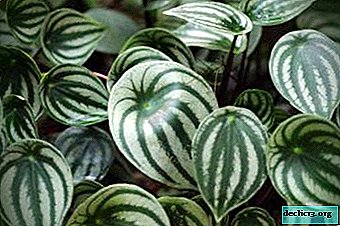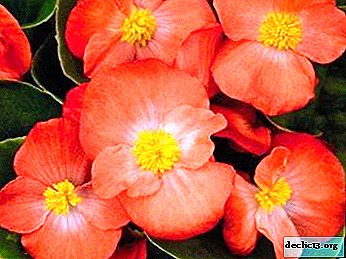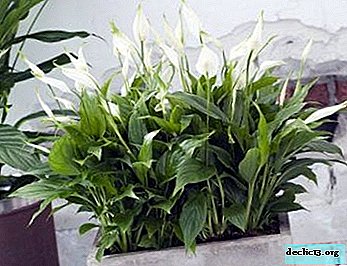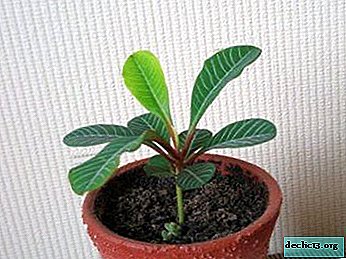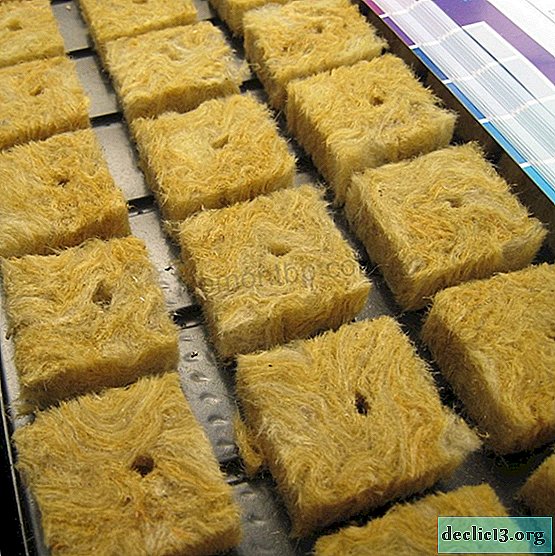The amazing rose of Abracadabra: description and photo of the variety, use in landscape design, care and other nuances
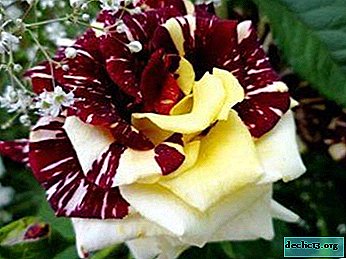
Rosa Abracadabra (Abracadabra) is surprising, and sometimes perplexing, to everyone who saw her for the first time.
The variety got its name thanks to its extraordinary color, which combines all kinds of shades of red, yellow, brown and white.
This variety, despite the fact that it was bred relatively recently, has already gained popularity and has gained recognition among flower growers. In the article, we consider its advantages and disadvantages, as well as describe how to grow.
Grade description
Rosa Abracadabra belongs to the family Rosaceae, to a grade of tea hybrid roses. This is a perennial plant in the form of a spreading or upright bush, a variant with a shape in the form of a standard tree with a height of 50 to 150 cm is also possible. The stems are dark green, prickly. The leaves are green, glossy, stiff, when grown on open ground they can acquire a brownish tint.
Abracadabra flowers are large, from 8 to 12 cm in diameter, double, with a high center and a pointed shape with velvet petals. They can either be located singly on a high peduncle, or be collected in inflorescences of several pieces. The highlight of this variety is the color of the buds: a fancy combination of all shades of yellow, red, white, brown, and sometimes purple flowers will not leave anyone indifferent.
Rose has a faint pleasant aroma reminiscent of women's perfume. With good care, it is able to bloom several times during the summer, and in greenhouses - almost all year round. The advantages of the variety include the fact that, although it is shearing, however, the rose survives well in the open ground. However, do not forget that it was originally intended primarily for growing in greenhouses, as varieties for cutting.
As a result Abracadabra has the following characteristics:
- winter hardiness - medium (climatic zone 6a (from -20.6 ° C to 23.3 ° C) - 9a (from -3.9 ° C to -6.7 ° C));
- disease resistance - medium (especially to powdery mildew);
- resistance to rain is weak;
- resistance to drought - medium;
- requirements for the acid composition of the soil - from 5.6 to 7.3.
Photo
Further on the photo you can see what the rose of Abracadabra looks like.





History of occurrence
Speaking about the history of the creation of such an unusual variety, it is necessary to mention that today it has three varieties:
- Abracadabra tea hybrid.
- Abracadabra floribunda, Kordes, 2002.
- Abracadabra floribunda, Kordes, 2004.
The first of them, Abracadabra tea-hybrid, is the founder of the entire series. It was created in the nursery of California by the American William Warriner in 1991 by crossing a tea and a repair rose. The varieties "White Masterpiece" and "Tribute" formed the basis.
Two years later, in 1993, Abracadabra was represented at the exhibition by the Jackson and Perkins Company, and quickly gained the attention and recognition of the public. The following two varieties were created in Germany, in the W. Kordes & Sons nursery, using the then-popular Hocus Pocus variety in 2002 and 2005, respectively.
What is the difference from the rest of the species?
First of all, Abracadabra differs from other types of roses in its extremely original color. Due to the unusual color, it is comparable only with the Focus Pocus variety, but Abracadabra has more stripes on its petals. Also, unlike the progenitor, which is able to fade to the same burgundy over time, it stably keeps a motley color. Among its advantages is the simplicity of reproduction: it reproduces well by vaccination, budding and cuttings. Planted bushes the next year can give flowering. Suitable for dry regions.
Bloom
 With the right choice of landing site, Abracadabra blooms, luxuriantly and abundantly, almost all summer. If you plant it in the ground in the fall, then in the very first summer the variety will already give buds. The rose blooms to frost, after a cold snap the flowers do not hold. An exception are greenhouses in which Abracadabra can bloom year-round.
With the right choice of landing site, Abracadabra blooms, luxuriantly and abundantly, almost all summer. If you plant it in the ground in the fall, then in the very first summer the variety will already give buds. The rose blooms to frost, after a cold snap the flowers do not hold. An exception are greenhouses in which Abracadabra can bloom year-round.
Sometimes in the first year of flowering, Abracadabra produces exclusively yellow buds, but you should not record the bush as defective. Next summer, the rose will surprise with bizarre flowers, among which it will be impossible to find two of the same.
During flowering, plant care is required as usual. Flowering bush should not be fedbut after full flowering, as well as during periods of decline in flowering, Abracadabra needs fertilizers. Watering is standard. Also, as it fades, it will be necessary to remove wilted buds - this stimulates the appearance of new ones.
If Abracadabra does not bloom, then most likely the matter is the wrong choice of place. It is necessary to protect the plant from drafts, make sure that diffused sunlight falls on it. If you planted a rose in the shade of trees, fences or buildings, you can not wait for flowering, it will not happen. Also, the problem may be in improper, poor soil. Among gardeners there is an opinion that this variety blooms best on chernozems.
Use in landscape design
This variety of roses, due to its bright and unusual colors, is very much appreciated in landscape design. With its help you can design any garden or park in an original way.
The classic background for the roses of Abracadabra is considered:
- Combination with coniferous cultures: spruce, juniper, thuja.
- Any climbing rose with monophonic buds - it is planted behind Abracadabra to shade its unusual color. Such a flower bed would be appropriate to look at the front door.
At a distance of 1.5 m from the flower garden with Abracadabra, any flowering and fruit shrubs can be planted. The rose goes well with such cultures as lilac, scoopia, yellow acacia, cotoneaster, euonymus, snowberry, goof, sea buckthorn, privet, tamarix, mock up.
You can also place it next to mahonia, pyrocantha and cotoneaster horizontal. Among perennial plants, lavender, periwinkle, veronica, bluebells, delphinium and blue and white asters are suitable as neighbors for Abracadabra. Of the annuals - lobelia, agerantum.
When combining Abracadabra with solid colors, it should be planted in the foreground. Then the result will be a bright, memorable composition.Step-by-step care instructions
Everyone can grow Abracadabra in their own area (if the climate zone is suitable), the main thing is to follow the recommendations for caring for this plant and plant it correctly.
Seat selection
 This is one of the main points on which it depends on whether the rose will bloom and whether it will take root in principle. The variety requires an open, sunny place, blown by the winds. The latter is especially important because the rose is not resistant to moisture and should dry quickly after rain and dew.
This is one of the main points on which it depends on whether the rose will bloom and whether it will take root in principle. The variety requires an open, sunny place, blown by the winds. The latter is especially important because the rose is not resistant to moisture and should dry quickly after rain and dew.
Otherwise, fungal diseases cannot be avoided. When growing varieties in the southern regions, it is worth paying attention to the fact that the plant is not located in the open sun. This will contribute to the appearance of sunburn on the petals. Also you need to take care of a small hill, because in the lowlands, cold air accumulates, not useful for roses.
Timing
It is optimal to plant bushes in the fall, so that the plant has time to grow stronger and adapt before the onset of winter.
The soil
It blooms best on chernozem. It can be planted in loamy soil, but it is important to ensure that groundwater does not occur nearby. Liming is used for acidic soils, and clay areas are improved by adding peat.
Landing
Abracadabra can be propagated both by seeds and seedlings. The first method is a bit more complicated and is only suitable for experienced gardeners. It is best to take seeds collected for him independently. If this was not possible, you need to carefully select the seeds. The packaging should indicate the collection and shelf life of the seed, it is advisable to take the seeds of this year.
Also, the packaging should be intact, not wrinkled and without signs of strong moisture. Purchased seeds need to be treated with hydrogen peroxide, then placed on a moist substrate of gauze, covered with another layer of the same, placed in a cool dark place and wait for germination. Plant germinated seeds in small pots and wait until the seedlings grow, so that they can be transplanted into the ground.
Purchased seedlings need to choose with sleeping buds, without green shoots, so that the seedling does not weaken, spending nutrients. Externally, the seedling bark should look healthy, green, without spots, streaks and brownings. It is also important to inspect the root system - it should not be damaged.
- Before planting, the seedling root is dipped in water for 6-10 hours.
- Then a hole is dug at least 0.5 m in depth, a drainage is placed at the bottom.
- Organic fertilizer, such as compost, is added.
- Then, a future rose is placed in the recess and carefully covered with earth.
- Immediately after transplanting, the plant must be watered.
Temperature
Rose is able to grow in the range from +30 to -10 ° C (when sheltering for the winter). The optimum temperature will be + 20-25 ° C
Watering
Watering is required regularly, but without waterlogging.. Once a week will be enough. It is best to water in the early morning, under the root, then loosen the ground.
Top dressing
It is required in March, April, June and July, with an interval of 8-9 days. It is optimal to use specialized complex fertilizers for roses or cow manure, diluted in water.
Weeding
Regular, at least once a week, is required to prevent the formation of soil crust.
Pruning
Pruning requires spring and autumn. Spring is held until the awakening of the buds, in order to form a beautiful bush and abundant flowering. Autumn, the so-called preventive, is performed with the advent of cold weather in dry weather. Shoots are removed to the middle of the branch.
Transfer
It is not necessary to transplant Abracadabra. The only situation in which this may be needed is during very cold winters. Then it’s worth gently digging out the rose, transplanting it into a box of wet sand and placing it in the basement.
Preparation for winter
The variety does not tolerate wintertherefore, if the temperature drops below -5 ° C, you need to cover the rose with fir spruce branches or garden polyethylene. Pre-cut it. It is important to check that damp does not accumulate under the shelter, and ventilate during periods of thaw.
Breeding
Abracadabra successfully propagated by vaccination, budding and cuttings. This is usually done in the fall or summer.
Cuttings
 Reproduction begins at the end of June or in July.
Reproduction begins at the end of June or in July.
Necessary:
- Cut semi-lignified annual flowering shoots.
- Take their middle part and divide into segments, each of which should contain 2-3 kidneys. The bottom cut is 3 millimeters below the last sheet. The bottom sheet is removed.
- Root a stalk in a shaded place in a greenhouse.
- After rooting, plant in a wet and dense soil to a depth of 1.5 cm.
- In winter, transplant into pots and leave in a bright, cool place.
Budding
In this way, you can increase the number of varietal bushes in the second half of July or in August. The eyes are grafted into the root neck of a one-year-old bush or into a strong shoot.
Graft
In spring, you can be vaccinated "in the split" or "over the bark" cuttings, cut back in the fall and stored under snow or in the sand in the basements.
Diseases and Pests
In relation to this species, Abracadabra is not resistant to rust and powdery mildew. From the first, it is treated with 0.4% copper chloride, and from the second it is treated with a 1% solution of the Topaz preparation, a 1% solution of the Bordeaux mixture, or 0.2% solution of the Baleyton preparation. It can also be affected by spider mites, caterpillars, bugs and aphids. Against them used drugs "Sunmayt", "Mospilan", "Confidor maxi" or "Acrofit".
The variety of roses "Abracadabra" is able to decorate any garden with its flowering. And, although it is not easy to reproduce and care,, having blossomed, it will pay off all efforts.


